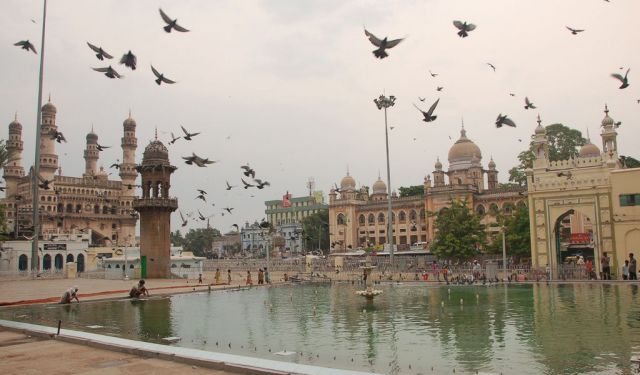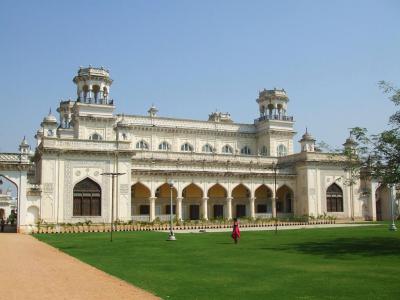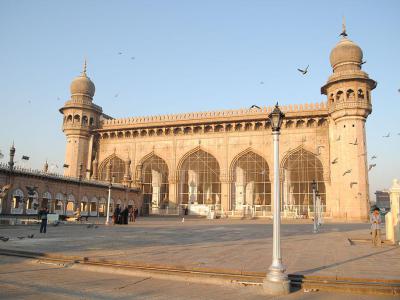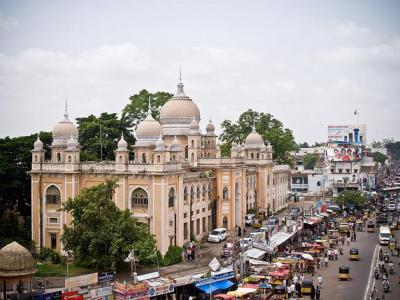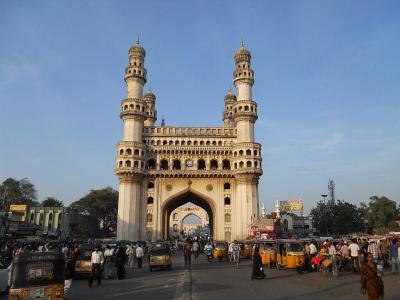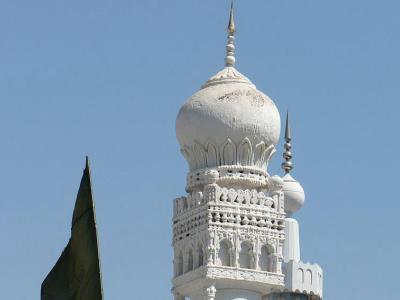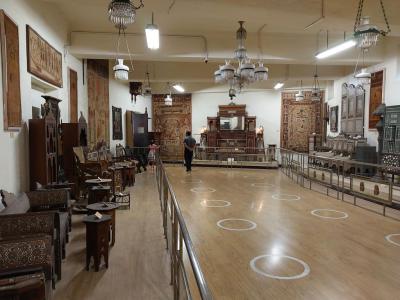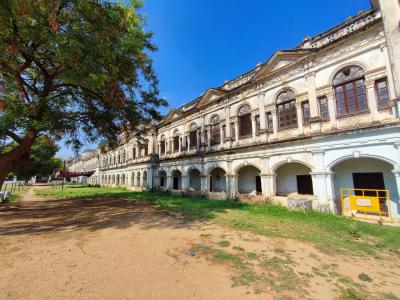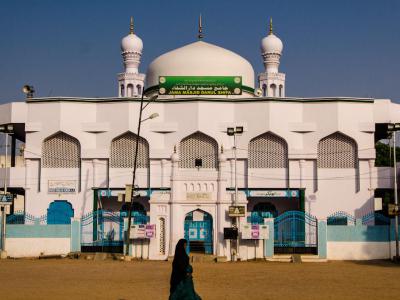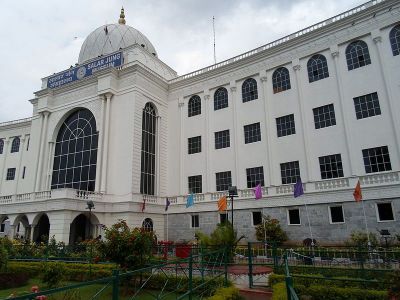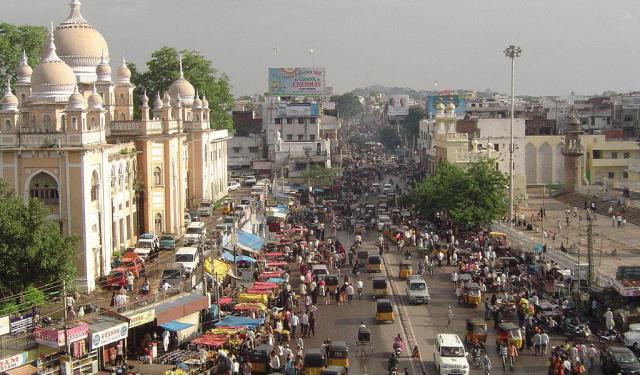Hyderabad Old Town Tour (Self Guided), Hyderabad
The capital and the largest city of the southern Indian state of Andhra Pradesh, Hyderabad is particularly renowned for its Old Town part, rich in attractions, such as Chowmahalla Palace, Nizam Museum and several ancient mosques, some of which date back to the 16th century. Take this self-guided tour to explore these and other prominent landmarks of Hyderabad's Old Town.
How it works: Download the app "GPSmyCity: Walks in 1K+ Cities" from Apple App Store or Google Play Store to your mobile phone or tablet. The app turns your mobile device into a personal tour guide and its built-in GPS navigation functions guide you from one tour stop to next. The app works offline, so no data plan is needed when traveling abroad.
Hyderabad Old Town Tour Map
Guide Name: Hyderabad Old Town Tour
Guide Location: India » Hyderabad (See other walking tours in Hyderabad)
Guide Type: Self-guided Walking Tour (Sightseeing)
# of Attractions: 9
Tour Duration: 2 Hour(s)
Travel Distance: 3.8 Km or 2.4 Miles
Author: Xena
Sight(s) Featured in This Guide:
Guide Location: India » Hyderabad (See other walking tours in Hyderabad)
Guide Type: Self-guided Walking Tour (Sightseeing)
# of Attractions: 9
Tour Duration: 2 Hour(s)
Travel Distance: 3.8 Km or 2.4 Miles
Author: Xena
Sight(s) Featured in This Guide:
- Chowmahalla Palace
- Mecca Masjid
- Government Nizamia General Hospital
- Charminar
- Jama Masjid
- Nizam Museum
- Purani Haveli
- Darul Shifa Jama Masjid
- Salar Jung Museum
1) Chowmahalla Palace (must see)
Chowmahalla Palace or Chowmahallat (4 Palaces), is a palace of the Nizams of Hyderabad state. It was the seat of the Asaf Jahi dynasty and was the official residence of the Nizams of Hyderabad while they ruled their state. The palace remains the property of Barkat Ali Khan Mukarram Jah, heir of the Nizams.
In Persian, Chahar means four and in Arabic Mahalat (plural of Mahal) means palaces, hence the name Chowmahallat means four palaces. All ceremonial functions including the accession of the Nizams and receptions for the Governor-General were held at this palace. The prestigious UNESCO Asia Pacific Merit award for cultural heritage conservation was presented to Chowmahalla Palace on March 15, 2010. UNESCO representative Takahiko Makino formally handed over the plaque and certificate to Princess Esra, former wife and GPA holder of Prince Mukarram Jah Bahadur.
While Salabat Jung initiated its construction in 1750, it was completed by the period of Afzal ad-Dawlah, Asaf Jah V, the V Nizam ensured its completion between 1857 and 1869. The palace is unique for its style and elegance. Building of the palace began in the late 18th century and over the decades a synthesis of many architectural styles and influences emerged. This palace consists of two courtyards, southern courtyard and northern courtyard. They have elegant palaces, the grand Khilwat (the Dharbar Hall), fountains and gardens. The palace originally covered 45 acres (180,000 square meters), but only 14 acres (57,000 square meters) remain today.
Khilwat Mubarak is the heart of Chowmahalla Palace. It is held in high esteem by the people of Hyderabad, as it was the seat of the Asaf Jahi dynasty. The grand pillared Durbar Hall has a pure marble platform on which the Takht-e-Nishan or the royal seat was laid. Here the Nizams held their durbar and other religious and symbolic ceremonies. The 19 spectacular Chandeliers of Belgian crystal recently reinstalled to recreate the lost splendor of this regal hall.
The clock above the main gate to Chowmahalla Palace is affectionately called as Khilwat Clock. It has been ticking away for around 250 years. An expert family of clock repairers winds the mechanical clock every week. Council Hall housed a rare collection of manuscripts and priceless books.The Nizam often met important officials and dignitaries here.Today it is venue for temporary exhibitions from the treasures of the Chowmahalla Palace Collection that of a bygone era.
In Persian, Chahar means four and in Arabic Mahalat (plural of Mahal) means palaces, hence the name Chowmahallat means four palaces. All ceremonial functions including the accession of the Nizams and receptions for the Governor-General were held at this palace. The prestigious UNESCO Asia Pacific Merit award for cultural heritage conservation was presented to Chowmahalla Palace on March 15, 2010. UNESCO representative Takahiko Makino formally handed over the plaque and certificate to Princess Esra, former wife and GPA holder of Prince Mukarram Jah Bahadur.
While Salabat Jung initiated its construction in 1750, it was completed by the period of Afzal ad-Dawlah, Asaf Jah V, the V Nizam ensured its completion between 1857 and 1869. The palace is unique for its style and elegance. Building of the palace began in the late 18th century and over the decades a synthesis of many architectural styles and influences emerged. This palace consists of two courtyards, southern courtyard and northern courtyard. They have elegant palaces, the grand Khilwat (the Dharbar Hall), fountains and gardens. The palace originally covered 45 acres (180,000 square meters), but only 14 acres (57,000 square meters) remain today.
Khilwat Mubarak is the heart of Chowmahalla Palace. It is held in high esteem by the people of Hyderabad, as it was the seat of the Asaf Jahi dynasty. The grand pillared Durbar Hall has a pure marble platform on which the Takht-e-Nishan or the royal seat was laid. Here the Nizams held their durbar and other religious and symbolic ceremonies. The 19 spectacular Chandeliers of Belgian crystal recently reinstalled to recreate the lost splendor of this regal hall.
The clock above the main gate to Chowmahalla Palace is affectionately called as Khilwat Clock. It has been ticking away for around 250 years. An expert family of clock repairers winds the mechanical clock every week. Council Hall housed a rare collection of manuscripts and priceless books.The Nizam often met important officials and dignitaries here.Today it is venue for temporary exhibitions from the treasures of the Chowmahalla Palace Collection that of a bygone era.
Sight description based on Wikipedia.
2) Mecca Masjid (must see)
Mecca Masjid, also Makkah Masjid, is one of the oldest mosques in Hyderabad and it is one of the largest Mosques in India. Makkah Masjid is a listed heritage building in the old city of Hyderabad, close to the historic landmarks of Chowmahalla Palace,Laad Bazaar, and Charminar. Muhammad Quli Qutb Shah, the fifth ruler of the Qutb Shahi dynasty, commissioned bricks to be made from the soil brought from Mecca, the holiest site of Islam, and used them in the construction of the central arch of the mosque, thus giving the mosque its name. It formed the centerpiece around which the city was planned by Muhammad Quli Qutub Shah.
The main hall of the mosque is 75 feet high, 220 feet wide and 180 feet long, enough to accommodate 10,000 worshipers at a time. Fifteen arches support the roof of the main hall, five on each of the three sides. A wall rises on the fourth side to provide Mihrab. At the peak of the minarets flanking the mosque is an arched gallery, and above that a smallish dome and a spire. Inscriptions from the Qur'an adorn many of the arches and doors. The main structure of the mosque is sandwiched between two massive octagonal columns made out of a single piece of granite. The cornices running around the entire mosque structure and the floral motifs and friezes over the arches remind the tourist of the great attention paid to detail in Qutub Shahi architecture. They have a close resemblance to the arches at Charminar and Golkonda Fort.
The Makkah Masjid is a listed heritage building, however, lack of maintenance and growing pollution has withered and cracked the structure. It received a chemical wash in 1995. To prevent further damage, the Andhra Pradesh government made Charminar a traffic-free zone in August 2001.
On the edge of the pond are two stone and slab benches, whoever sits on them, according to legend, returns to sit on them again. A room in the courtyard is believed to house a hair of the Islamic prophet Muhammed.
The main hall of the mosque is 75 feet high, 220 feet wide and 180 feet long, enough to accommodate 10,000 worshipers at a time. Fifteen arches support the roof of the main hall, five on each of the three sides. A wall rises on the fourth side to provide Mihrab. At the peak of the minarets flanking the mosque is an arched gallery, and above that a smallish dome and a spire. Inscriptions from the Qur'an adorn many of the arches and doors. The main structure of the mosque is sandwiched between two massive octagonal columns made out of a single piece of granite. The cornices running around the entire mosque structure and the floral motifs and friezes over the arches remind the tourist of the great attention paid to detail in Qutub Shahi architecture. They have a close resemblance to the arches at Charminar and Golkonda Fort.
The Makkah Masjid is a listed heritage building, however, lack of maintenance and growing pollution has withered and cracked the structure. It received a chemical wash in 1995. To prevent further damage, the Andhra Pradesh government made Charminar a traffic-free zone in August 2001.
On the edge of the pond are two stone and slab benches, whoever sits on them, according to legend, returns to sit on them again. A room in the courtyard is believed to house a hair of the Islamic prophet Muhammed.
Sight description based on Wikipedia.
3) Government Nizamia General Hospital
Government Nizamia General Hospital popularly known as Government Unani Hospital is a public hospital located in Hyderabad. It is a hospital for general medicine and Unani medicine. It was established during the reign of Nizams. It is located near the historic Charminar.
Nizamia General Hospital was built in 1938 by the last Nizam of Hyderabad State, HEH Osman Ali Khan. The departments at the hospital include Gynaecology, Surgery, Dentistry, Ophthalmology, Pathology and many others. A medical college, Government Nizamia Tibbi College is located on the campus.
Nizamia General Hospital was built in 1938 by the last Nizam of Hyderabad State, HEH Osman Ali Khan. The departments at the hospital include Gynaecology, Surgery, Dentistry, Ophthalmology, Pathology and many others. A medical college, Government Nizamia Tibbi College is located on the campus.
Sight description based on Wikipedia.
4) Charminar (must see)
The Charminar, built in 1591 CE, is a monument and mosque located in Hyderabad. The landmark has become a global icon of Hyderabad, listed among the most recognized structures of India. The Charminar is on the east bank of Musi river. To the northeast lies the Laad Bazaar and in the west end lies the granite-made richly ornamented Makkah Masjid. The English name is a transliteration and combination of the Urdu words Chār and Minar, translating to "Four Towers"; the eponymous towers are ornate minarets attached and supported by four grand arches.
The Archaeological Survey of India (ASI), the current undertaker of the structure, mentions in its records that: "There are various theories regarding the purpose for which Charminar was constructed. However, it is widely accepted that Charminar was built at the center of the city, to commemorate the eradication of plague", as Muhammad Quli Qutb Shah had prayed for the end of a plague that was ravaging his city and vowed to build a Mosque at the very place where he prayed.
Mohammed Quli Qutb Shah laid the Charminar, the structure was intended to serve as a Mosque and Madraasa. Mir Momin Astarabadi, the prime minister of Qutb Shah played a leading role to prepare the layout plan for the Charminar along with the new capital city (Hyderabad), the additional eminent architects from Persia were also invited to develop the city plan. the structure is of Indo-Islamic architecture style, incorporating Persian architectural elements. The Charminar was constructed on the intersection of the historical trade route that connects the markets of the Golconda with the port city of Masulipatnam. The Hyderabad city was designed keeping Charminar as a center piece. The city was spread around the Charminar in four different quadrants and chambers, segregated according to the established settlements.
The Archaeological Survey of India (ASI), the current undertaker of the structure, mentions in its records that: "There are various theories regarding the purpose for which Charminar was constructed. However, it is widely accepted that Charminar was built at the center of the city, to commemorate the eradication of plague", as Muhammad Quli Qutb Shah had prayed for the end of a plague that was ravaging his city and vowed to build a Mosque at the very place where he prayed.
Mohammed Quli Qutb Shah laid the Charminar, the structure was intended to serve as a Mosque and Madraasa. Mir Momin Astarabadi, the prime minister of Qutb Shah played a leading role to prepare the layout plan for the Charminar along with the new capital city (Hyderabad), the additional eminent architects from Persia were also invited to develop the city plan. the structure is of Indo-Islamic architecture style, incorporating Persian architectural elements. The Charminar was constructed on the intersection of the historical trade route that connects the markets of the Golconda with the port city of Masulipatnam. The Hyderabad city was designed keeping Charminar as a center piece. The city was spread around the Charminar in four different quadrants and chambers, segregated according to the established settlements.
Sight description based on Wikipedia.
5) Jama Masjid (must see)
The white towers of the Jama Masjid, the oldest mosque in Hyderabad, rise a few meters from the Charminar. It was built by Muhammad Quli Qutub Shah in the year 1597 after the completion of the Charminar.
Within the premises of Jama masjid lie the ruins of an old Turkish bath. Formerly, a school and a monastery used to lie within the walls of the mosque, but they no longer exist presently. The Jama Masjid is still frequented by a large number of Muslims and remains one of the principal places of worship in the city.
Within the premises of Jama masjid lie the ruins of an old Turkish bath. Formerly, a school and a monastery used to lie within the walls of the mosque, but they no longer exist presently. The Jama Masjid is still frequented by a large number of Muslims and remains one of the principal places of worship in the city.
6) Nizam Museum
Nizam Museum or H.E.H Nizam's Museum is a museum located in Hyderabad at Purani Haveli, a palace of the erstwhile Nizams. This museum showcases the gifts that the last Nizam of Hyderabad state, Osman Ali Khan, Asaf Jah VII received on his silver jubilee celebrations.
The museum is a repository mainly of souvenirs, gifts and mementos presented by dignitaries to the last Nizam gifts and mementos presented to the last Nizam on the occasion of the silver jubilee celebrations in 1936. Models made of silver of all the landmark buildings in Hyderabad, and citations in Urdu about H.E.H. Mir Osman Ali Khan.
A golden, wooden throne used for the silver jubilee celebrations of the Last Nizam, a gold tiffin box inlaid with diamonds, miniature repilica of the Jubilee Hall, glass inlay painting of Mir Osman Ali Khan. Also, a wooden writing box studded with mother-of-pearl, diamond and gold-studded daggers, caskets, and silver ittardans (perfume containers) presented by the raja of palvancha. silver coffee cups studded with diamonds and silverfiligree elephant with mahout are on display.
A 1930 Rolls Royce, Packard and a Jaguar Mark V are among the vintage cars on display. The museum also features the wardrobe of the sixth nizam, a 150-year-old manually operated lift, and 200-year-old proclamation drums. The museum was opened on February 18, 2000 by the Nizam Trust to the general public.
The museum is a repository mainly of souvenirs, gifts and mementos presented by dignitaries to the last Nizam gifts and mementos presented to the last Nizam on the occasion of the silver jubilee celebrations in 1936. Models made of silver of all the landmark buildings in Hyderabad, and citations in Urdu about H.E.H. Mir Osman Ali Khan.
A golden, wooden throne used for the silver jubilee celebrations of the Last Nizam, a gold tiffin box inlaid with diamonds, miniature repilica of the Jubilee Hall, glass inlay painting of Mir Osman Ali Khan. Also, a wooden writing box studded with mother-of-pearl, diamond and gold-studded daggers, caskets, and silver ittardans (perfume containers) presented by the raja of palvancha. silver coffee cups studded with diamonds and silverfiligree elephant with mahout are on display.
A 1930 Rolls Royce, Packard and a Jaguar Mark V are among the vintage cars on display. The museum also features the wardrobe of the sixth nizam, a 150-year-old manually operated lift, and 200-year-old proclamation drums. The museum was opened on February 18, 2000 by the Nizam Trust to the general public.
Sight description based on Wikipedia.
7) Purani Haveli
Purani Haveli is a palace located in Hyderabad. It was the official residence of the Nizam. It was also known as Haveli Khadeem, which means old mansion, was constructed for Sikander Jah, Asaf Jah III (1803–1829) by his father Ali Khan Bahadur, Asaf Jah II.
The 2nd Nizam Mir Nizam Ali Khan had taken over this from Rukunudhaulah of the Momin dynasty, in 1717. The main building is a symbol of 18th century European architecture. Sikander Jha lived here for some time and later shifted to Khilwat Mahal. Due to this, these buildings are called Purani Haveli. In this building complex, Ayina Khaana (Mirror House) and Chini Khaana (Chinese Glass House) were constructed. Now the South Zone Deputy Commissioner of Police (Hyderabad) and South Zone Task Force Police Addl DCP offices are being functioned here.
The Haveli is "U" in shape, with two oblong wings running parallel to each other and the residential palace located perpendicularly in the middle. The main building resembles 18th-century European palaces. A unique feature of this palace is the world's longest wardrobe, built in two levels with a hand-cranked wooden lift (elevator) in place. This occupies the entire length of one wing of the palace.
The 2nd Nizam Mir Nizam Ali Khan had taken over this from Rukunudhaulah of the Momin dynasty, in 1717. The main building is a symbol of 18th century European architecture. Sikander Jha lived here for some time and later shifted to Khilwat Mahal. Due to this, these buildings are called Purani Haveli. In this building complex, Ayina Khaana (Mirror House) and Chini Khaana (Chinese Glass House) were constructed. Now the South Zone Deputy Commissioner of Police (Hyderabad) and South Zone Task Force Police Addl DCP offices are being functioned here.
The Haveli is "U" in shape, with two oblong wings running parallel to each other and the residential palace located perpendicularly in the middle. The main building resembles 18th-century European palaces. A unique feature of this palace is the world's longest wardrobe, built in two levels with a hand-cranked wooden lift (elevator) in place. This occupies the entire length of one wing of the palace.
Sight description based on Wikipedia.
8) Darul Shifa Jama Masjid
Darul Shifa Jama Masjid (Darushifa Jama Masjid) was constructed more than 400 years ago, by Mohammed Quli Qutub Shah (The Founder of Hyderabad) on the banks of River Musi. The Mosque is flooded by worshipers Specially on Friday and Ramazan covering the Ground of Jama Masjid. "Maulana Hamid Uddin Aqil Hussami", used to lead the Friday Prayers until his death on 11 March 2010.
Sight description based on Wikipedia.
9) Salar Jung Museum (must see)
The Salar Jung Museum is an art museum located at Darushifa, on the southern bank of the Musi river in the city of Hyderabad. It is one of the three National Museums of India. It has a collection of sculptures, paintings, carvings, textiles, manuscripts, ceramics, metallic artefacts, carpets, clocks, and furniture from Japan, China, Burma, Nepal, India, Persia, Egypt, Europe, and North America. The museum's collection was sourced from the property of the Salar Jung family.
The Indian historical collections includes: the paintings of legendary Raja Ravi Varma; Aurangzeb's sword; Jade crafted daggers of Emperor Jehangir, Noorjahan and Shah Jehan; a wardrobe of Tipu Sultan and a tiffin box made of gold and diamond. The furniture collection belonging from the time of Louis 14th-17th and Napoleon. Salar Jung III collected about 43,000 artifacts and 50,000 books and manuscripts out of which only few are displayed in today's museum.
The museum building in a semicircular shape with 38 galleries, spread on two floors, displays only a part of the original collections. The ground floor has 20 galleries and the first floor has 18 galleries. The exhibits on different subjects are displayed in separate galleries. Each gallery is huge and has many artefacts on display including ones dated back to the 17th century. Apart from the galleries, there is a reference Library, reading room, publication and education section, chemical conservation lab, sales counter, cafeteria etc. Guides are available at fixed timings free of charge.
There are Aurangzeb's daggers belonging to empress Noor Jehan, emperors Jehangir and Shah Jehan, the turbans and chair of Tippu Sultan, furniture from Egypt, paintings on display. Among the sculptures stands out the world famous statue of Veiled Rebecca by G.B. Benzoni, an Italian sculptor, in 1876. Her beautiful face hazily is visible through a marble but gossamer veil. Equally captivating is a double-figure wood sculpture. It stands before a mirror and shows the facade of a nonchalant Mephistopheles and the image of a demure Margaretta in the mirror. The eastern section is of equal importance with its wide variety of silk weaving and different art forms, including layer wood cutting paintings, porcelain works and many more, dating back to almost 2ndcentury.
The Museum has a famous Quran Collection from around the World in different fonts and designs. The Quran Written with Gold and Silver, There are many more collections of religious books,as well as Arabic Quran.
A bewildering variety and array of clocks greets the visitor in the clock room. There are ancient Sandiaers in the form of obelisks to huge and modern clocks of the twentieth century. Others in the range vary from miniature clocks which need a magnifying glass to imbibe their beauty and complexity to stately grandfather clocks from as far away as France, Germany, Italy, Switzerland and Britain. A visual delight is the musical clock Salar Jung bought from Cook and Kelvey of England. Every hour, a timekeeper emerges from the upper deck of the clock to strike a gong as many times as it is the hours of the day.
The Indian Parliament has declared the museum an Institution of National Importance. The museum is open from 10:00 to 17:00 (except on Friday). Camera/Mobile Camera are allowed for Rs.50.
The Indian historical collections includes: the paintings of legendary Raja Ravi Varma; Aurangzeb's sword; Jade crafted daggers of Emperor Jehangir, Noorjahan and Shah Jehan; a wardrobe of Tipu Sultan and a tiffin box made of gold and diamond. The furniture collection belonging from the time of Louis 14th-17th and Napoleon. Salar Jung III collected about 43,000 artifacts and 50,000 books and manuscripts out of which only few are displayed in today's museum.
The museum building in a semicircular shape with 38 galleries, spread on two floors, displays only a part of the original collections. The ground floor has 20 galleries and the first floor has 18 galleries. The exhibits on different subjects are displayed in separate galleries. Each gallery is huge and has many artefacts on display including ones dated back to the 17th century. Apart from the galleries, there is a reference Library, reading room, publication and education section, chemical conservation lab, sales counter, cafeteria etc. Guides are available at fixed timings free of charge.
There are Aurangzeb's daggers belonging to empress Noor Jehan, emperors Jehangir and Shah Jehan, the turbans and chair of Tippu Sultan, furniture from Egypt, paintings on display. Among the sculptures stands out the world famous statue of Veiled Rebecca by G.B. Benzoni, an Italian sculptor, in 1876. Her beautiful face hazily is visible through a marble but gossamer veil. Equally captivating is a double-figure wood sculpture. It stands before a mirror and shows the facade of a nonchalant Mephistopheles and the image of a demure Margaretta in the mirror. The eastern section is of equal importance with its wide variety of silk weaving and different art forms, including layer wood cutting paintings, porcelain works and many more, dating back to almost 2ndcentury.
The Museum has a famous Quran Collection from around the World in different fonts and designs. The Quran Written with Gold and Silver, There are many more collections of religious books,as well as Arabic Quran.
A bewildering variety and array of clocks greets the visitor in the clock room. There are ancient Sandiaers in the form of obelisks to huge and modern clocks of the twentieth century. Others in the range vary from miniature clocks which need a magnifying glass to imbibe their beauty and complexity to stately grandfather clocks from as far away as France, Germany, Italy, Switzerland and Britain. A visual delight is the musical clock Salar Jung bought from Cook and Kelvey of England. Every hour, a timekeeper emerges from the upper deck of the clock to strike a gong as many times as it is the hours of the day.
The Indian Parliament has declared the museum an Institution of National Importance. The museum is open from 10:00 to 17:00 (except on Friday). Camera/Mobile Camera are allowed for Rs.50.
Sight description based on Wikipedia.
Walking Tours in Hyderabad, India
Create Your Own Walk in Hyderabad
Creating your own self-guided walk in Hyderabad is easy and fun. Choose the city attractions that you want to see and a walk route map will be created just for you. You can even set your hotel as the start point of the walk.
Hyderabad Cultural Venues
Hyderabad is the city of contrasts. There are many cultural sites and places of interest to explore here, including NTR Memorial, State Archeology Museum, Public Gardens and many religious sites, such as Birla Mandir (Hindu temple), St Joseph's (Roman Catholic) Cathedral and more.
Tour Duration: 2 Hour(s)
Travel Distance: 5.3 Km or 3.3 Miles
Tour Duration: 2 Hour(s)
Travel Distance: 5.3 Km or 3.3 Miles
The Most Popular Cities
/ view all
